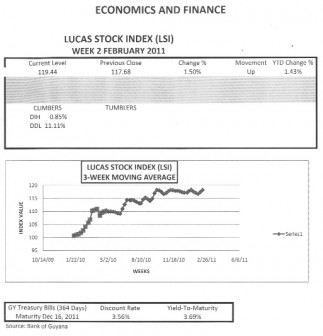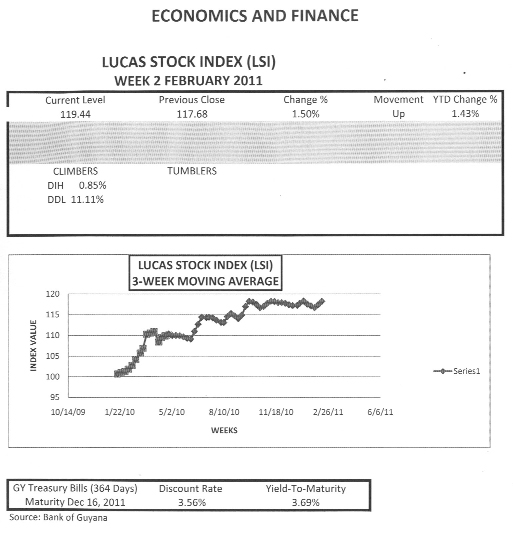Lagging
The Guyana Marketing Corpo-ration was rejiggered. The Nation-al Agricultural Research Institute is to be reconfigured. New varieties of agricultural crops are to be introduced. Special financing programs have been developed for small farmers. Several supply chain arrangements are in place. A “Grow More Food” campaign and an export drive are in progress. Despite these changes and developments, “other agriculture” production in Guyana remains way below where it was in 2000. The lagging crop production has left juice producers scrambling and edible oil manufacturers complaining and scratching their heads. There is no doubt that confidence levels in the reliability of the agricultural infrastructure have dropped since the floods of 2005 and 2006. But, the condition of the sector as it is and its inability to restore production to at least 2000 levels make Guyanese wonder about the soundness and effectiveness of the agricultural strategy being pursued by the administration.
Potential
While it no longer holds the economic reins of the country, agriculture remains an important part of the Guyana economy. It accounts for about 20 percent of the output of the country and about 18 percent of the revenue earned by stakeholders of the sector. The non-traditional component of this sector continues to emerge as an important element in the evolution of the agricultural sector. It is the business of small-scale and low-technology farmers. Despite the size and philosophy, this sector harbours much economic potential both for value-added contributions and export revenue.
Good Fortune
The 2011 budget reported that output of non-traditional agriculture expanded by 2.5 percent in 2010, following an expansion of 2 percent in 2009. As small as the annual expansion is, there is little doubt that the non-traditional agricultural sector is generating some energy among its stakeholders. Some of its progress might stem from good fortune. It has taken advantage of the consequential decline in sugar to acquire equal status in generating revenue within the agricultural sector. Like sugar, it contributes an average of 20 percent of the income earned by stakeholders within the sector. Yet, success within the sector might be masking serious problems with how the strategy is being implemented and the equity of its supporting policies.
Euphemism
The occasion of the budget presentation has been used to talk about the strategy of choice in pursuit of agricultural production. As in previous years, the administration will continue in 2011 to promote the development and export of non-traditional agricultural crops. It is doing this through the use of what it calls “wide-reaching and integrated programmes and targeted projects”. This catchall phrase really looks like a euphem-ism for the reintroduction of past policies and philosophies that worked for agriculture in Guyana. It might also be seen as a way of spreading resources around to remind the piper of who must call the tune. According to the 2011 budget, the administration will spend money reconfiguring NARI, setting up financing arrangements for preferred farmers, rebuilding the infrastructure and developing the Guyana Livestock Develop-ment Authority (GLDA), the new and improved version of the National Dairy Development Programme (NDDP).
Weakness
There are about 23 items in service of the policy to use the non-traditional agricultural sector to diversify the Guyana economy. Items included in the list are coconuts, cassava, plantain, hot pepper, cucumber, pumpkin, passion fruit, watermelon, bora, ginger, lime, eschallot, black-eye peas and the like. All the products except black-eye peas have an export market somewhere in the Caribbean, Europe or North America. Despite the reported growth in income, output and market focus, the non-traditional sector is running on a treadmill. The national accounts reveal that the share of the non-traditional agricultural sector to the Guyana economy is five percent. This is what its contribution was under the old GDP series and that is what it is under the new GDP series. Des-pite the G$1.3 billion spent last year, the contribution of non-traditional agriculture to the Guyana economy did not grow in 2010 either. The evidence shows up in the production statistics coming out of the Ministry of Agriculture and once again point to a weakness in the implementation of the strategy.
Inconsistent Results

The parade of numbers from the Ministry of Agriculture provides good evidence of the malfunction of the policy. Since 2000, the output of pulses is down 88 percent. The output of mangoes is down 87 percent. The output of cassava is down 79 percent. The output of eschallot is down 51 percent. The output of citrus is down 27 percent. Some products have displayed less production trauma but remain sources of concern. The production of hot pepper is down 17 percent compared to a 70 percent decline in 2008. The output of plantain is down 14 percent compared to an 89 percent decline in 2008. The output of bora is down four percent compared to a 67 percent decline in 2008. It is clear from the production numbers that the policy is producing inconsistent results. The administration plans to spend G$1.5 billion this year on this component of the agriculture sector. This represents a per capita expenditure of under G$2,000 and is half of what it plans to spend on sugar.
Deficient
More work is needed to determine the cause of the limited effectiveness of the policy. The amount of money spent on the sector is clearly insufficient and a search in the usual places like infrastructural problems and inappropriate technology might turn up other problems. Guyanese should not rule out the impact of an item like the value-added tax (VAT) on the condition of the non-traditional sector. All agricultural products are subject to VAT; however, a select few incurs no tax because the rate applied is zero. Fresh fruits,

